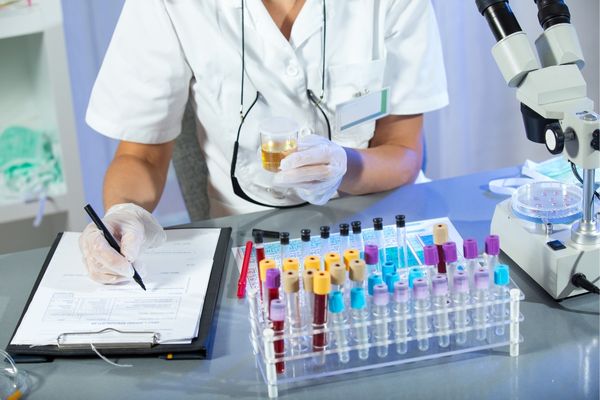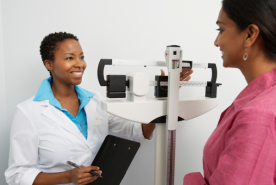October 27, 2022
This might be an awkward question, but have you had your pee tested lately? A urinalysis or urine test gives healthcare professionals a clearer picture of your kidney function and overall health. Here's how.
What is a Urinalysis?
It's not particularly fun to pee into a cup at the doctor's office, but what healthcare providers can find in just two tablespoons of urine makes it all worth it–signs of serious conditions like kidney disease, diabetes, and liver disease.
While this may sound like magic, healthcare professionals use a combination of what they can see with the naked eye, a microscope, and a plastic strip with chemicals on it called a dipstick to determine whether or not something may be wrong with your health.
- Visual exam: Healthcare professionals look at the color and clearness for signs of kidney disease or infection.
- Microscopic: A microscope helps healthcare professionals find things that don't belong, like red or white blood cells, bacteria, or crystals that could turn into kidney stones.
- Dipstick test: This helpful tool determines acidity (pH) and looks for signs of diabetes, liver issues, infection, or kidney problems.
Red or Dark Brown Urine
If you notice that your urine is red or dark brown, don't panic but do get it checked out by a professional. While certain medications or foods could cause this color, it could also be blood. Blood in the urine, called hematuria, occurs when the filters of the kidneys or another part of the urinary tract aren't working correctly or are damaged.
There are two types of hematuria:
- Microscopic hematuria: There will be no visible signs of blood to the naked eye, which is why frequent urinalysis tests are so important.
- Gross hematuria: Urine appears red or the color of tea or cola.
Foamy or Fizzy Urine
Do you see foamy or fizzy bubbles when you use the bathroom? It could simply be from the force of your urine hitting the water in the toilet bowl–especially if you had to go very badly.
Bubbles, especially ones that require multiple flushes, can be a sign of protein in the urine or albuminuria (proteinuria). One of the kidney's most important jobs is to remove waste products and extra water from the blood. If the kidneys are damaged, protein–which belongs in the blood–can also get filtered out.
Unfortunately, protein doesn't always make urine foamy or fizzy, so a urinalysis is the only way to know if it is there.
Having protein in your urine doesn't automatically mean you have kidney damage. Your healthcare professional will test you over the next three months. If each result is positive for protein, you may have kidney disease. You may also get blood work to determine your eGFR or a kidney biopsy to find kidney damage.
Join the NKF Blog Newsletter
Get inspirational stories and kidney disease resources delivered to your inbox every month. You'll gain practical insights and expert advice to help you better understand and manage your kidney health no matter where you are on your kidney journey. Subscribe today.
Urine that Smells
If you notice that your urine smells more than usual, don't be too alarmed. Dehydration or certain foods like asparagus or Brussel sprouts can cause bad-smelling urine. However, it's always better to be safe than sorry, so let your healthcare professional know. They will determine whether you need a urinalysis.
When to Get a Urine Test
Even if you don't have any symptoms, frequent urine testing is a great way to keep track of your overall health. Take it from George, a kidney transplant recipient with no signs of kidney disease until they failed.
"Unless you are doing an annual checkup," said George, "you don't know what's going on inside your body. My kidney failed because of glomerulonephritis…not something that generally shows up unless you're having a checkup."
Don't wait to visit a healthcare professional if you notice anything odd about your urine. Coby, a kidney transplant recipient, saw blood in his urine for years but avoided going to the doctors until he experienced symptoms of kidney failure.
"I would urinate blood and I would get acne all over my legs. By the end of college, I really started to notice a big decline in athletic performance and was waking up with soaking wet bed sheets. My ankles were swollen but my buddies said I was just getting old," Coby said. Years later, "They did blood work and my creatinine level was through the roof. All my basic kidney numbers were in the gutter."
Had Coby gotten tested earlier, he may have been able to have managed his kidney disease to maintain kidney function for longer.
Are you at risk of kidney disease? Take this one-minute quiz to find out.









